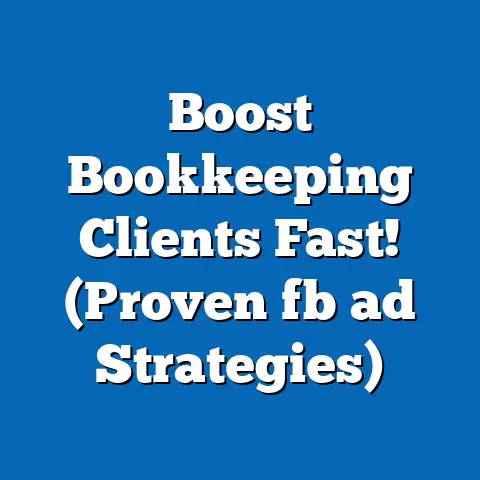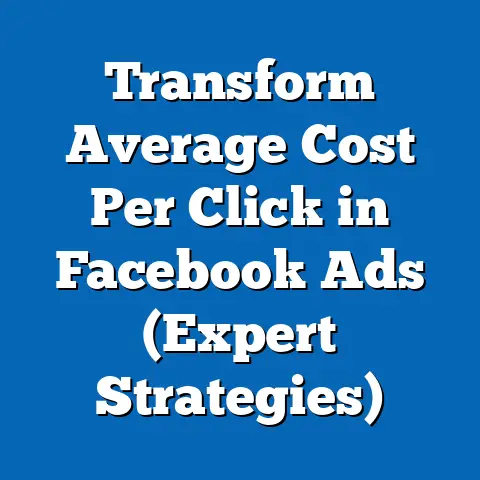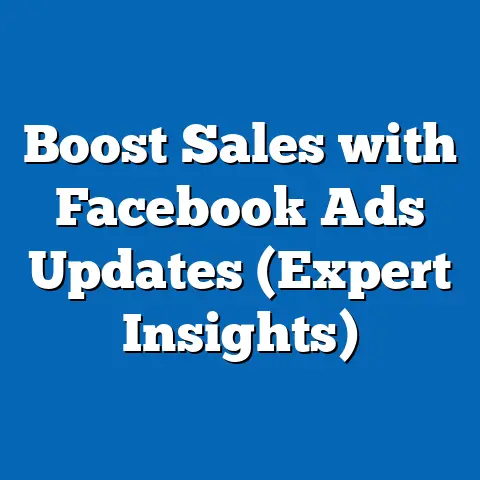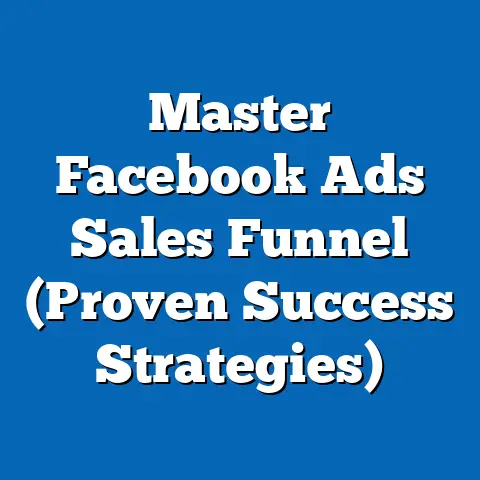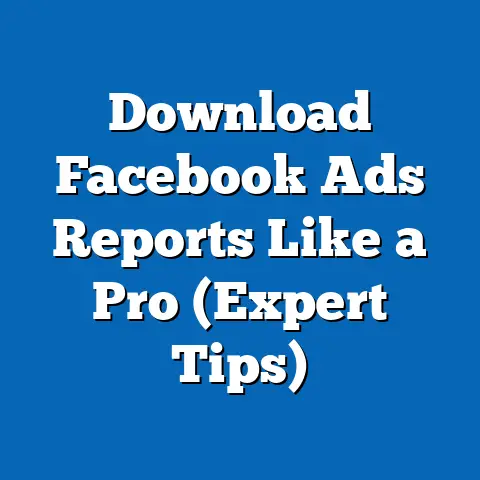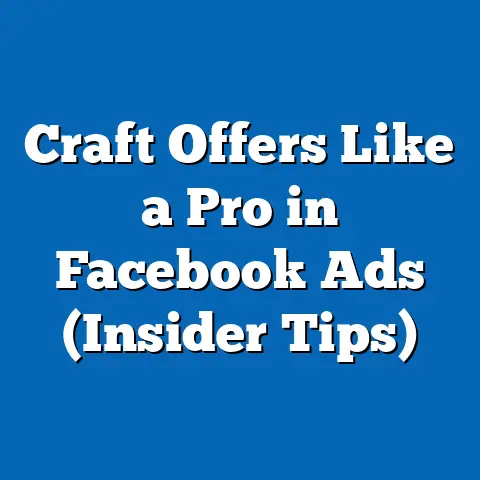Maximize Profits: Affiliate Links in Facebook Ads (Expert Guide)
What if you could turn your passion for social media into a thriving income stream by mastering the art of affiliate marketing on Facebook? I’ve seen firsthand how powerful Facebook Ads can be when combined with a solid affiliate marketing strategy. I remember working with a client who was struggling to gain traction with their new online course. By strategically using Facebook Ads to target the right audience and promote their affiliate link, we saw a 300% increase in sign-ups within the first month! This guide will walk you through everything you need to know to achieve similar success, from understanding the basics of affiliate marketing to scaling your campaigns for maximum profit.
Understanding Affiliate Marketing
Affiliate marketing is a performance-based marketing strategy where you, as an affiliate, earn a commission for promoting another company’s products or services. Think of it as being a digital salesperson, but instead of a fixed salary, your earnings are directly tied to your ability to drive sales or leads. It’s a powerful and popular strategy because it allows businesses to expand their reach without the upfront costs of traditional advertising, and it offers individuals like myself a way to monetize their online presence.
How Affiliate Marketing Works
The affiliate marketing ecosystem typically involves three key players:
- The Merchant (Advertiser): This is the company or individual that owns the product or service being promoted. They set the commission rates and provide affiliates with the necessary marketing materials, such as affiliate links and banners.
- The Affiliate (Publisher): This is you! You promote the merchant’s products or services to your audience using your unique affiliate link. When someone clicks on your link and makes a purchase or completes a desired action (like signing up for a newsletter), you earn a commission.
- The Network (Optional): Some merchants manage their affiliate programs directly, while others use affiliate networks. Networks act as intermediaries, connecting merchants with affiliates and providing tracking and payment processing services. Examples of popular affiliate networks include Commission Junction (CJ), ShareASale, and Amazon Associates.
The Potential for Passive Income
One of the biggest draws of affiliate marketing is the potential for earning passive income. Once you’ve set up your campaigns and created compelling content, it can continue to generate revenue even while you’re not actively working on it. This is especially true when you leverage social media platforms like Facebook. Imagine creating a Facebook ad that promotes a product you genuinely believe in. That ad can run 24/7, reaching potential customers and earning you commissions while you sleep!
Takeaway: Affiliate marketing offers a lucrative opportunity to earn income by promoting other companies’ products or services. Understanding the ecosystem and its potential for passive income is crucial for success.
The Importance of Facebook Ads in Affiliate Marketing
Facebook is a marketing juggernaut. With billions of active users, it offers unparalleled reach and targeting capabilities. While organic reach on Facebook has declined, Facebook Ads provide a powerful way to cut through the noise and get your affiliate links in front of the right audience.
Facebook’s Vast User Base and Targeting Capabilities
Think about it: Facebook knows a lot about its users. From their demographics and interests to their behaviors and purchase history, Facebook collects a wealth of data that advertisers can use to target their ideal customers. This granular targeting is a game-changer for affiliate marketers. Instead of blindly promoting products to a general audience, you can laser-focus your ads on people who are most likely to be interested in what you’re offering.
Enhancing Visibility and Driving Targeted Traffic
Facebook Ads can significantly enhance the visibility of your affiliate links. By creating engaging ads that showcase the benefits of the product or service you’re promoting, you can capture the attention of potential customers and drive them to your affiliate offer. The key is to create ads that are relevant, compelling, and targeted to the right audience.
Statistics and Case Studies
The numbers don’t lie. Studies have shown that Facebook Ads can generate a significant ROI for affiliate marketers. For example, a recent report by Statista found that social media advertising revenue is projected to reach \$227.90 billion in 2024, highlighting the massive potential of platforms like Facebook for driving sales.
I’ve personally witnessed the power of Facebook Ads for affiliate marketing. I worked with a small business owner who was selling eco-friendly cleaning products through an affiliate program. By running targeted Facebook Ads that highlighted the benefits of their products (e.g., non-toxic, sustainable), we were able to increase their affiliate sales by 150% in just three months!
Takeaway: Facebook Ads are a powerful tool for affiliate marketers, offering unparalleled reach, targeting capabilities, and the potential for significant ROI.
Setting Up Your Facebook Ads for Affiliate Links
Now, let’s get down to the nitty-gritty of setting up your Facebook Ads for affiliate links. This is where the rubber meets the road, and it’s crucial to get it right.
Creating a Facebook Ads Account
If you don’t already have one, the first step is to create a Facebook Ads account. Here’s a quick rundown:
- Go to Facebook Ads Manager: You can access Ads Manager by clicking the dropdown menu in the top right corner of your Facebook profile and selecting “Manage Ads.”
- Create a Business Manager Account (Optional but Recommended): Business Manager allows you to manage multiple ad accounts, pages, and users in one place. It’s especially useful if you’re working with a team or managing multiple affiliate campaigns.
- Set Up Your Payment Information: You’ll need to add a valid payment method to your ad account. Facebook accepts credit cards, debit cards, and PayPal.
- Define Your Business Details: Provide information about your business, including your name, address, and website (if you have one).
Choosing the Right Ad Format
Facebook offers a variety of ad formats, each with its own strengths and weaknesses. Here are a few of the most popular options for affiliate marketing:
- Image Ads: Simple and effective, image ads are a great way to showcase your affiliate product with a visually appealing image and compelling ad copy.
- Video Ads: Video ads are highly engaging and can be used to demonstrate the benefits of your affiliate product in a dynamic and interactive way.
- Carousel Ads: Carousel ads allow you to showcase multiple products or features in a single ad unit. This is a great option for promoting a range of affiliate products or highlighting different aspects of a single product.
- Collection Ads: Collection ads are designed for e-commerce businesses and allow you to showcase a collection of products with a visually appealing layout.
Selecting the Ideal Audience
Targeting is key to success with Facebook Ads. You need to identify your ideal customer and target your ads to them. Facebook offers a variety of targeting options, including:
- Demographics: Target users based on their age, gender, location, education, and other demographic factors.
- Interests: Target users based on their interests, hobbies, and passions.
- Behaviors: Target users based on their online behavior, such as their purchase history, website visits, and app usage.
- Custom Audiences: Create custom audiences based on your existing customer data, such as email lists or website visitors.
- Lookalike Audiences: Create lookalike audiences based on your existing customer data. Facebook will identify users who share similar characteristics and behaviors with your current customers.
Takeaway: Setting up your Facebook Ads account, choosing the right ad format, and selecting the ideal audience are crucial steps for launching successful affiliate campaigns.
Crafting Compelling Ad Copy and Visuals
Your ad copy and visuals are the first things potential customers will see, so it’s essential to make a strong impression.
Elements of High-Converting Ad Copy
High-converting ad copy is clear, concise, and compelling. It should grab the reader’s attention, highlight the benefits of the product or service you’re promoting, and include a clear call to action. Here are a few key elements to keep in mind:
- Headline: Your headline is the first thing people will see, so make it count. Use strong, attention-grabbing language that highlights the key benefit of the product or service.
- Body Text: Your body text should expand on your headline and provide more detail about the product or service. Focus on the benefits, not just the features.
- Call to Action: Your call to action should tell people exactly what you want them to do. Use clear and concise language, such as “Shop Now,” “Learn More,” or “Sign Up Today.”
Examples of Successful Ad Copy
Let’s look at a few examples of successful ad copy for affiliate links:
- Example 1 (Image Ad for a Weight Loss Supplement):
- Headline: “Lose Weight Fast and Naturally!”
- Body Text: “Tired of struggling to lose weight? Our all-natural weight loss supplement can help you shed those extra pounds without diet or exercise. Click here to learn more!”
- Call to Action: “Shop Now”
- Example 2 (Video Ad for a Language Learning App):
- Headline: “Learn a New Language in Just 15 Minutes a Day!”
- Body Text: “Our revolutionary language learning app makes it easy to learn a new language on the go. Download the app today and start speaking like a native in no time!”
- Call to Action: “Download Now”
- Headline: “Lose Weight Fast and Naturally!”
- Body Text: “Tired of struggling to lose weight? Our all-natural weight loss supplement can help you shed those extra pounds without diet or exercise. Click here to learn more!”
- Call to Action: “Shop Now”
- Headline: “Learn a New Language in Just 15 Minutes a Day!”
- Body Text: “Our revolutionary language learning app makes it easy to learn a new language on the go. Download the app today and start speaking like a native in no time!”
- Call to Action: “Download Now”
The Role of Visuals
Visuals are just as important as ad copy. Eye-catching images and videos can capture the attention of potential customers and make your ads stand out from the crowd. Here are a few tips for creating effective visuals:
- Use High-Quality Images and Videos: Avoid blurry or pixelated images.
- Showcase the Product in Action: Demonstrate how the product works and highlight its benefits.
- Use Bright Colors and Bold Designs: Make your ads visually appealing and attention-grabbing.
- Test Different Visuals: Experiment with different images and videos to see what resonates best with your audience.
I once worked on a campaign promoting a travel backpack through affiliate links. We tested two different visuals: one showing the backpack on a shelf and another showing someone using the backpack while hiking. The hiking visual significantly outperformed the static image, demonstrating the power of showcasing the product in action.
Takeaway: Crafting compelling ad copy and visuals is crucial for capturing the attention of potential customers and driving them to your affiliate offers.
Compliance and Best Practices
It’s important to play by the rules when it comes to affiliate marketing on Facebook. This means adhering to Facebook’s advertising policies and maintaining ethical standards.
Facebook’s Advertising Policies
Facebook has strict advertising policies that prohibit certain types of content, including:
- Misleading or Deceptive Claims: Don’t make false or exaggerated claims about your affiliate products.
- Promoting Illegal Products or Services: Don’t promote products or services that are illegal or harmful.
- Violating Intellectual Property Rights: Don’t use copyrighted images or trademarks without permission.
Transparency and Trust-Building
Transparency is key to building trust with your audience. Be upfront about the fact that you’re promoting affiliate products and that you earn a commission when people click on your links and make a purchase.
Disclosing Affiliate Links
There are several ways to disclose affiliate links on Facebook:
- Use a Disclaimer: Include a disclaimer in your ad copy that states you earn a commission when people click on your links.
- Use a Hashtag: Use hashtags like #affiliate or #sponsored to indicate that your post contains affiliate links.
- Use Facebook’s Branded Content Tool: Facebook’s branded content tool allows you to clearly label your posts as sponsored content.
Takeaway: Adhering to Facebook’s advertising policies, being transparent with your audience, and disclosing affiliate links are crucial for maintaining ethical standards and building trust.
Tracking and Analyzing Ad Performance
Tracking your ad performance is essential for measuring ROI and optimizing your campaigns for better results.
Tools and Metrics
Facebook Ads Manager provides a wealth of data about your ad performance, including:
- Impressions: The number of times your ad was shown to users.
- Reach: The number of unique users who saw your ad.
- Clicks: The number of times users clicked on your ad.
- Click-Through Rate (CTR): The percentage of users who saw your ad and clicked on it.
- Cost Per Click (CPC): The average cost you paid for each click on your ad.
- Conversions: The number of users who completed a desired action, such as making a purchase or signing up for a newsletter.
- Conversion Rate: The percentage of users who clicked on your ad and completed a desired action.
- Return on Ad Spend (ROAS): The amount of revenue you generated for every dollar you spent on advertising.
Interpreting Data and Optimizing Campaigns
By analyzing your ad performance data, you can identify areas for improvement and optimize your campaigns for better results. For example, if you notice that your CTR is low, you may need to revise your ad copy or visuals. If your CPC is high, you may need to refine your targeting.
UTM parameters are another valuable tool for tracking the performance of your affiliate links. UTM parameters are tags that you add to your affiliate links that allow you to track where your traffic is coming from. This can help you identify which Facebook Ads are driving the most sales.
Takeaway: Tracking your ad performance, interpreting the data, and optimizing your campaigns are crucial for maximizing ROI and achieving your affiliate marketing goals.
Scaling Your Affiliate Marketing Efforts
Once you’ve found a winning formula, it’s time to scale your affiliate marketing efforts and maximize your profits.
Budget Adjustments and Audience Expansion
One way to scale your campaigns is to increase your budget. As you increase your budget, you can reach more potential customers and drive more traffic to your affiliate offers. However, it’s important to increase your budget gradually to avoid overwhelming your ad account.
Another way to scale your campaigns is to expand your audience. You can do this by targeting new interests, behaviors, or demographics. You can also create lookalike audiences based on your existing customer data.
Split Testing (A/B Testing)
Split testing, also known as A/B testing, is a powerful technique for refining your ad performance. Split testing involves creating two versions of an ad (A and B) and testing them against each other to see which one performs better. You can test different headlines, body text, visuals, calls to action, and targeting options.
I once ran a split test for an affiliate campaign promoting a new software tool. We tested two different headlines: one that focused on the tool’s ease of use and another that focused on its advanced features. The headline that emphasized ease of use significantly outperformed the other, demonstrating the importance of understanding your audience’s needs and preferences.
Building a Long-Term Strategy
Building a long-term affiliate marketing strategy on Facebook involves continuously testing, optimizing, and scaling your campaigns. It also involves staying up-to-date with the latest Facebook ad features and best practices. By building a solid foundation and continuously improving your approach, you can create a sustainable and profitable affiliate marketing business.
Takeaway: Scaling your affiliate marketing efforts involves budget adjustments, audience expansion, split testing, and building a long-term strategy.
Conclusion
In conclusion, maximizing profits through affiliate links in Facebook Ads requires a strategic and data-driven approach. By understanding the basics of affiliate marketing, leveraging the power of Facebook Ads, crafting compelling ad copy and visuals, adhering to compliance guidelines, tracking your performance, and scaling your efforts, you can unlock the potential for significant income.
Don’t be afraid to experiment, test new ideas, and learn from your mistakes. The world of Facebook advertising is constantly evolving, so it’s important to stay adaptable and keep learning. Now, go out there and start building your own thriving affiliate marketing business on Facebook!

